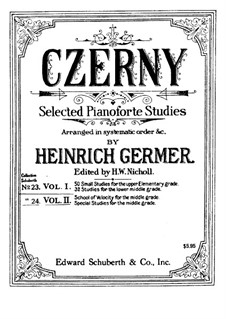

had been mastered – and that the teacher should intersperse attractive rondos and variations containing difficult passagework in order to demonstrate the need for long and trying hours of technical drill. Czerny himself was later to recommend that the beginner be given only selected exercises – once notes, scales, arpeggios, etc. It is pedagogically significant that Beethoven urged Czerny not to criticize too closely the accuracy of Karl’s playing, because he believed that an over-strict adherence to the notes might hamper the development of musical ideas and interpretation. However, when at fifteen Czerny was himself established as one of the most respected piano-teachers in Vienna, with among his many pupils the brilliant eight-year-old Ninette von Belleville, Beethoven entrusted to him his nephew and ward, Karl. So rapid and facile were Czerny’s powers of memorization that Beethoven once criticized him for not playing more with music, arguing that he would lose his skill for sight-reading and might neglect certain dynamic marks in performance. Having heard Beethoven improvise a pianoforte reduction of Gluck’s Iphigenia in Tauris, he begged the master to lend him the score of the opera, took it home, and wrote down from memory the reduction as Beethoven had played it! This remarkable feet of ear and musicality may well have encouraged him to begin his own career as composer, for it was in that year, 1805, that his Opus 1 appeared : Concertante, Variationen für Clavier und Violine über ein Thema von Krumpholz. Even more astounding was an event of the year before. First of all, however, get him a copy of Emmanuel Bach’s book on the true art of piano playing, for he must bring it with him each time he comes.”ĭuring the earliest lessons, Beethoven kept him altogether on scales in all the keys, teaching him correct hand-position and fingering and in particular the use of thumbs, those hitherto neglected parts of the hands, as if he knew his new pupil was one day to write a brilliant etude entitled “The Passing Under of the Thumb.” Beethoven’s own works were the core of Karl’s study every new composition he learned immediately and played from memory, the “Emperor” concerto for example, when he was only fifteen. I will teach him myself and accept him as my pupil. First he played the Mozart C Major Concerto, then, noticing that Beethoven’s interest seemed to flag a bit, he dared to play the master’s “Pathetique” Sonata and later accompanied while his father sang the “Adelaide.” This so pleased and excited Beethoven that he said to Czerny’s father, “The boy has talent. Czerny recalls in his memoirs “How I looked forward to and feared the day when I should meet this wondrous man! Even today (1842) that scene remains alive in my memory.” It was a decisive day in Czerny’s life, certainly. In 1801 Krumpholz took father and son to visit Beethoven so that the boy could play for him. His extraordinary gifts engaged the interest of his father’s friend Wenzel Krumpholz, a violinist at the Court theater and a passionate admirer of Beethoven. Pohl – had made himself acquainted with “almost all” the important contemporary keyboard literature, “most of which” he could play from memory. By the time he was ten he was an excellent sight-reader and – according to his biographer, C. However, political unrest caused the family to move once more back to Vienna, where Karl was to live the rest of his life.Īs early as the age of three Karl, like other Wünderkinder, was playing little pieces on the piano, and his father brought him up on a solid diet of Bach, Clementi, Mozart, and early Beethoven. In 1791, a few months after baby Karl was born, Wenzel and his wife moved to Poland, where the father taught music in a nobleman’s house until Karl was four.

Born in the small Czech town of Nimberg, Wenzel Czerny came as a young man to Vienna in 1750 to make his way as a piano teacher. If pianistic and other musical gifts can be inherited, Karl Czerny’s came from his father, Wenzel, who was himself an excellent and well-trained pianist. Notes to the Musical Heritage Society Recording by Vivien Harvey Slater


 0 kommentar(er)
0 kommentar(er)
